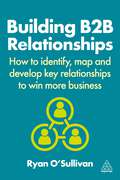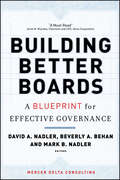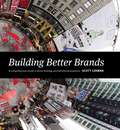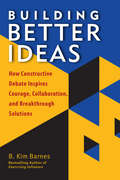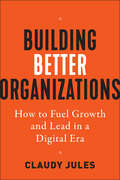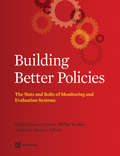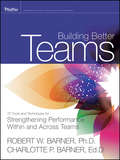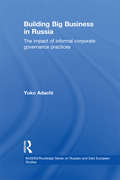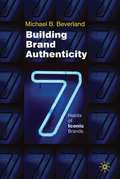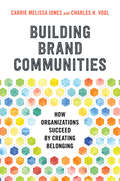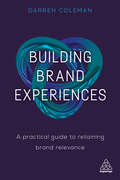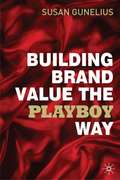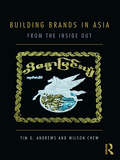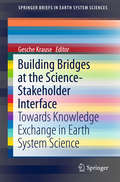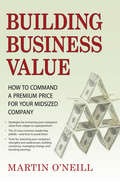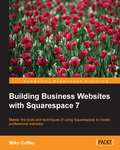- Table View
- List View
Building B2B Relationships: How to Identify, Map and Develop Key Relationships to Win More Business
by Ryan O'SullivanWith more people involved in B2B buying decisions and key accounts becoming more complex than ever, it's imperative to have clear visibility into who the decision makers are and a strategy for how you will engage with them. Building B2B Relationships presents a step-by-step guide to identifying, mapping, and developing key stakeholder relationships, helping you to win more and win faster. Providing a flexible methodology that can sit alongside whatever sales process you have in place, this book supports your end-to-end relationship management effort, whether it's helping you win more large complex deals, making new or important engagements a success or putting a framework in place to support the growth of your largest and most strategic accounts. By mapping, monitoring and measuring your relationships with all relevant stakeholders, you'll be able to better utilize each one. With real-world examples from major global organizations, learn how you can leverage your B2B relationships to maximize outcomes for all parties.
Building Better Arts Facilities: Lessons from a U.S. National Study. (Routledge Research in Creative and Cultural Industries Management)
by Joanna Woronkowicz D. Carroll Joynes Norman BradburnAt the turn of the 21st century, a significant boom in the construction of cultural buildings took saw the creation of hundreds of performing arts centers, theaters, and museums. After these buildings were completed, however, many of these cultural organizations struggled to survive, or, alternatively, drifted off mission as the construction project forced monetary or other considerations to be prioritized. Building Better Arts Facilities: Lessons from a U.S. National Study examines the ways in which organizations planned and managed building projects during this boom, and investigates organizational operations after projects were completed. By integrating quantitative data with case-study evidence, the authors identify the differences between the ways some organizations were able to successfully meet the challenges of a large construction project and others that were not. With empirical evidence and analysis, this book highlights better practices for managing and leading cultural building ventures. Readers of this book – be they arts managers, politicians, board members, city planners, foundation executives, or philanthropists – will find that book provides valuable perspective and insight about building cultural facilities, and that reading it will serve to make building projects go more smoothly in the future.
Building Better Boards: A Blueprint for Effective Governance (Jossey-bass Leadership Ser. #188)
by Mark B. Nadler David A. Nadler Beverly A. BehanPraise for Building Better Boards "Building Better Boards bridges the gap between talk and action. A must-read for board members, CEOs, governance experts - really for anyone who cares about the future of the corporation." Anne M. Mulcahy, chairman and CEO, Xerox Corporation "Building Better Boards covers all the key issues facing boards in the post-Sarbanes-Oxley era. It provides practical advice based on the authors' wide-ranging experience with major companies that have built successful boards." Marty Lipton, Wachtell, Lipton, Rosen Roger W. Raber, president and CEO, National Association of Corporate Directors "This book provides a comprehensive review and effective guide to making any board an effective team, and thus an asset, for their company." Richard H. Koppes of Counsel, Jones Day, and former general counsel, CalPERS "A balanced, insightful, thoughtful, and, above all, useful look at what can be done to create excellent boards." Edward E. Lawler III, director, Center for Effective Organizations, Marshall School of Business, University of Southern California "Improving board effectiveness is easier said than done. Building Better Boards lays out the how-tos in a clear and compelling way that is of practical value for directors and CEOs alike." Kenneth W. Freeman, former chairman and CEO, Quest Diagnostics Inc.
Building Better Brands: A Comprehensive Guide to Brand Strategy and Identity Development
by Scott LermanBuilding Better Brands is the essential guide to creating and evolving brands. Leveraging three decades of brand consulting for legendary companies like Caterpillar, Harley-Davidson, 3M, Owens-Illinois, National Australia Bank, and American Express, as well as middle-market and new-media startups, Scott Lerman shares the processes and frameworks needed to build great brands.This book is for you if you're a CEO seeking to enhance your knowledge of the branding process, a marketing/communications specialist who wants to take a leadership role in advancing an organizations brand, a brand consultant who is striving to sharpen and extend your skills, or a student who wants to jump-start a career in branding.Whatever its starting point--market leader or struggling competitor--any organization that follows this step-by-step guide will end up with a better brand.
Building Better Ideas: How Constructive Debate Inspires Courage, Collaboration, and Breakthrough Solutions
by B. Kim BarnesWhy do teams settle for bad ideas or kill good ones? Popular consultant B. Kim Barnes's unique process of constructive debate shows how teams can create better ideas and outcomes by eliminating obstacles to honest discussion, creativity, and collaboration. In too many organizations, great ideas and unusual solutions can be suppressed, ignored, or attacked. Departments defend their turf, and people choose what is safe over what is better. Bad ideas move forward and good ideas die, which can lead to disastrous results—financial or otherwise. Luckily, there is a workable path out of this dysfunction. Kim Barnes's process of constructive debate shows how to establish conditions that encourage the free exchange, discussion, and development of ideas and eliminate conditions that prevent potentially useful ideas from getting heard. By using this tested model, any company or team can improve outcomes and bring out everyone's best ideas.A constructive debate is one in which a diverse group of individuals can express their ideas, engage others in building on and improving them, explore ideas deeply, and challenge one another's positions in a fair and productive way. In this book, you'll learn a set of behaviors you can model and encourage and a process you can facilitate, lead, or support your client in leading. In this time, where opinions can be tribal and differences can lead to unconstructive conflict, it's important to find ways to build robust ideas through a thoughtful, fair, and inclusive approach.
Building Better Organizations: How to Fuel Growth and Lead in a Digital Era
by Claudy JulesThis essential playbook shows how companies can scale success by coupling digital strategies with an investment in the health of their organizations and the people within.To scale and grow, a company must get the organizational elements right. That begins with having the right strategy, the right leadership to drive it, and the right talent, culture, and organizational design to realize a company's potential. This is especially true in the AI era, where a company's most valuable assets are its people. To begin with, leaders must rethink their value creation strategies. To hone their organizational edge, leaders must prioritize their organization's health in seven vital areas: strategic direction, culture, leadership, talent, organizational design, EID (equity, inclusion, and diversity), and well-being. No matter what type or size of business, those essential conditions must be leveraged for increased value and growth. Put simply: organizational matters matter. To hone their digital edge, leaders must understand AI, as advances in technology allow leaders to build organizations that can compete and win in the future. Finally, an investor mindset will enable leaders to invest wisely in the technology (and leverage that tech) that sets their organizations apart.
Building Better Policies
by Keith Mackay Philipp Krause Gladys Lopez-AcevedoGovernments around the world face ongoing pressures from citizens to provide more and better services, and to do this while restraining taxation levels. This provides the context for government efforts to ensure their policies and programs are as effective, and as efficient, as possible. An emphasis on government performance has led a number of governments to create formal systems for monitoring and evaluating their performance--on a regular, planned, and systematic basis--with the objective of improving it. The focus of this book is on these government monitoring and evaluation (M and E) systems: what they comprise, how they are built and managed, and how they can be used to improve government performance.
Building Better Teams
by Robert Barner Charlotte P. BarnerOver the past 10 years in the field of human and organizational development, the approach to team building has moved from problem solving and conflict management to helping work groups and organizations build a foundation of trust, cooperation, and mutual support. Focusing on collaboration rather than resolving conflict, Building Better Teams: 70 Tools and Techniques for Strengthening Performance Within and Across Teams offers a fresh approach to team building. It provides proven tools for the most common needs of teams, including establishing trust, building consensus, managing change, working virtually and across boundaries, and dealing with setbacks.
Building Big Business in Russia: The Impact of Informal Corporate Governance Practices (BASEES/Routledge Series on Russian and East European Studies)
by Yuko AdachiThis book examines the development of big business in Russia since the onset of market oriented reform in the early 1990s. It explains how privatized post-Soviet enterprises, many of which made little sense as business units, were transformed into functional firms able to operate in the environment of a market economy. It provides detailed case studies of three key companies – Yukos Oil Company, Siberian (Russian) Aluminium and Norilsk Nickel – all of which played a key role in Russia’s economic recovery after 1998, describing how these companies were created, run and have developed. It shows how Russian businesses during the 1990s routinely relied on practices not entirely compatible with formal rules, in particular in the area of corporate governance. The book fully explores the critical role played by informal corporate governance practices - such as share dilution, transfer pricing, asset stripping, limiting shareholders access to votes, and 'bankruptcy to order’ - as Russian big business developed during the 1990s. Unlike other studies on Russian corporate governance, this book highlights the ambiguous impact of informal corporate governance practices on the companies involved as commercial entities, and suggests that although their use proved costly to Russia’s business reputation, they helped core groups of owners/managers at the time to establish coherent business firms. Overall, the book shows that we cannot understand the nature of current economic changes in Russia without recognising the crucial role played by informal corporate governance practices in the creation and development of big business in post-Soviet Russia.
Building Blockbuster Products and Services: Employ an Entrepreneurial Mindset
by Rita Gunther Mcgrath Ian MacmillanThe current business environment is tumultuous and full of uncertainty. What you need is an entrepreneurial mindset--a way of thinking about your business that captures the benefits of uncertainty. A key aspect of establishing an entrepreneurial mindset is creating the conditions under which everyone is energized to look for opportunities to change the current business model. The simplest way to change your business model is to redesign your products and services in ways that will be supremely appealing to your customers and highly profitable for your firm. This chapter shows you how. This chapter is excerpted from "The Entrepreneurial Mindset: Strategies for Continuously Creating Opportunity in an Age of Uncertainty."
Building Blockchain Projects
by Narayan PrustyThis book is for JavaScript developers who now want to create tamper-proof data (and transaction) applications using Blockchain and Ethereum. Those who are interested in cryptocurrencies and the logic and database empowering it will find this book extremely useful.
Building Brand Authenticity
by Michael BeverlandState of Our Unions 2009 seeks to answer the following questions: How is the Great Recession affecting the institution of marriage, as measured by changes in marriage and divorce rates in the United States? How do family finances---especially credit card debt and family assets---shape the quality and stability of contemporary married life in America? What does evolutionary psychology and the contemporary study of finance have to tell us about the best division of financial labor for husbands and wives? Is the Great Recession likely to foster egalitarian relationships between husbands and wives?
Building Brand Communities: How Organizations Succeed by Creating Belonging
by Charles Vogl Carrie Melissa JonesAn authentic brand community is more than just people buying your product or working alongside one another. This book articulates the critical roles of mutual concern, common values, and shared experiences in creating fiercely loyal customer and collaborator relationships. Smart organizations know that creating communities is the key to unlocking unprecedented outcomes. But too many mistakenly rely on superficial transactional relationships as a foundation for community, when really people want something deeper. Carrie Melissa Jones and Charles Vogl argue that in an authentic and enriching community, members have mutual concern for one another, share personal values, and join together in meaningful shared experiences, whether online or off. On the deepest level, brands must help members grow into who they want to be. Jones and Vogl present practices used by global brands like Yelp, Etsy, Twitch, Harley Davidson, Salesforce, Airbnb, Sephora, and others to connect in a meaningful way with the people critical for their success. They articulate how authentic communities can serve organizational goals in seven different areas: innovation, talent recruitment, customer retention, marketing, customer service, building transformational movements, and creating community forums. They also reveal principles to grow a new brand community to critical mass. This is the first comprehensive guide to a crucial differentiator that gives organizations access to untapped enthusiasm and engagement.
Building Brand Community on the Harley-Davidson Posse Ride
by Susan FournierThe second Harley-Davidson Posse Ride, a grueling 2,300 mile, 10-day trek from South Padre Island, Tex., to the Canadian Border is billed "for serious riders only." Harley Owner's Group (H.O.G.) Director Mike Keefe must decide whether this rolling rally deserves a place in the H.O.G. product line, and if so, what philosophy and tactics to adopt in future design. This case helps students get inside one of the world's strongest brands to consider issues of brand loyalty, close-to-the-customer philosophy, the cultivation of brand community, and the day-to-day execution of relationship marketing programs. What benefits accrue from relationship programs such as this? Can brand community be built? How? What is the role of the marketer in this process? Is it better to develop customer intimacy or empathy when executing close-to-the-customer goals? Can management really balance apparently disparate subcultures such as the retired bikers, Yuppie Weekend Warriors, and serious outlaws within one community? Includes color exhibits.
Building Brand Experiences: A Practical Guide to Retaining Brand Relevance
by Dr Darren ColemanRetaining brand relevance is fundamental to organizational success, and an increasing challenge that high-level marketing professionals now face. In the past, many have responded with product or price-based competition, yet this can only propel a brand so far when it comes to retaining long-term relevance. Research shows that consumers are in fact driven by emotion and positive brand experiences have the power to drive engagement, while simultaneously offering countless options for competitive differentiation. Building Brand Experiences enables managers and executives to realize this and create tailored, relevant experiences that will appeal to consumers and drive brand performance. Practically structured around The Brand Experience Blueprint, Building Brand Experiences provides a step-by-step guide to the process of building effective brand experiences based on tried-and-tested tools, templates and informed research. Combining expert insight and real-world examples in an anecdotal and digestible way, Building Brand Experiences is the essential guide to crafting relevant experiences that consumers will love, to improve brand engagement and drive results.
Building Brand Infosys
by Vidhya Muthuram Rohit DeshpandeInfosys Limited was India's second largest exporter of IT services with annual revenues of $7 billion and a market capitalization of nearly $26 billion in 2012. The company, headquartered in Bangalore, India, had built its reputation as the Indian IT bellwether whose credo was to "under-promise and over-deliver." Throughout its 31-year history, Infosys and its iconic co-founder, N.R. Narayana Murthy, were admired and respected for delivering excellence while conducting business in a legal, transparent, and ethical manner. It was one of the few software companies that recognized the value of a strong brand in the business-to-business (B2B) market and chose to develop its brand not through expensive advertising but by building core values, client trust, and leveraging Murthy's personal integrity and principles. In 2011, the company introduced its new brand positioning, Infosys 3.0. A key component of the new brand positioning was the Products, Platforms, and Services (PPS) business, headed by Sanjay Purohit. This case focuses on the company's efforts to makeover its brand in the U.S. market amidst several challenges.
Building Brand Value the Playboy Way
by Susan GuneliusWith $8000 and a dream to create a men's lifestyle magazine that he would like to read, Hugh Hefner put together the first issue of Playboy magazine on his kitchen table. Over half a century later, Playboy has grown to become one of most well known brands in the world, and Hefner remains the face of the brand and the ultimate brand champion. Susan Gunelius uncovers how a brand associated with sex survived and thrived despite attacks from every direction, in an increasingly competitive market and jaded consumers. For over 50 years, Hugh Hefner has lived the Playboy brand promise, and Playboy has become one of the most recognized brands in the world. It's a fascinating story of determination, dedication and belief in a product. It's the story of brand building, brand value, brand longevity and the ultimate brand champion.
Building Brands Without Mass Media
by David A. Aaker Erich JoachimsthalerCosts, market fragmentation, and new media channels that let customers bypass advertisements seem to be in league against the old ways of marketing. Relying on mass media campaigns to build strong brands may be a thing of the past. Several companies in Europe, making a virtue of necessity, have come up with alternative brand-building approaches and are blazing a trail in the post-mass-media age. In England, Nestle's Buitoni brand grew through programs that taught the English how to cook Italian food. The Body Shop garnered loyalty with its support of environmental and social causes. Cadbury funded a theme park tied to its history in the chocolate business. Haagen-Dazs opened posh ice-cream parlors and got itself featured by name on the menus of fine restaurants. Hugo Boss and Swatch backed athletic or cultural events that became associated with their brands.
Building Brands in Asia: From the Inside Out
by Wilson Chew Tim AndrewsIn a global business environment characterized by volatility and change, the formation of enduring relationships with consumers is paramount, but also notoriously difficult. Developing a unique brand personality is increasingly recognized as a key method to achieving the goal of customer loyalty. Focusing on the creation, development and management of brands in the world’s most dynamic, diverse and challenging business environment, Building Brands in Asia challenges the assumption that the continuing success of global brands in Asia is a given. The first part examines the challenge multinational corporations face in balancing brand consistency with local effectiveness. In the second part, attention shifts to Asian company brands, where the focus on branding has been relatively muted until now. Through a variety of sector and country contexts – from facilities management to football clubs, places to pop bands, home appliances to home weaving - we narrate simply and clearly the value, meaning, auditing, aligning, extending and architecture of brands from the likes of Haier, Ah Yee Taung, Axis Bank, OCS, Caltex, Manchester United and Thai Airways in markets as diverse as Japan, Laos, Korea and Singapore. Replete with anecdotes, interviews and case studies, Andrews and Chew provide an insightful, detailed and timely examination for all those interested in today’s primary corporate preoccupation set in the world’s most exciting marketplace.
Building Breakthrough Competences: And Competitive Advantage Employing an Entrepreneurial Mindset
by Rita Gunther Mcgrath Ian MacmillanThe current business environment is tumultuous and full of uncertainty. You need to adopt an entrepreneurial mindset--a way of thinking about your business that captures the benefits of uncertainty. This chapter focuses on entrepreneurial opportunities you can create by deliberately reconfiguring your company's competences--the combination of skills, assets, and systems you use to compete--to change the business model for your existing business or to create a business model for an entirely new venture. This chapter is excerpted from "The Entrepreneurial Mindset: Strategies for Continuously Creating Opportunity in an Age of Uncertainty."
Building Bridges Among the BRICs
by Robert CraneAll four authors of Building Bridges Among the BRICs take a close look at the national culture of their nations with their strengths and weaknesses for politics and business. They examine the origins of these cultures from the historical and geographical perspectives.
Building Bridges at the Science-Stakeholder Interface: Towards Knowledge Exchange In Earth System Science (SpringerBriefs in Earth System Sciences)
by Gesche KrauseThis book covers the approaches, applied methods and central participatory processes at the science-stakeholder interfaces embedded in the development of the "Earth System Knowledge Platform (ESKP)". The latter is an initiative of the German Helmholtz Association, synthesizing the expertise of the eight Helmholtz research institutions focusing on Earth System Sciences. The contributions showcase the approach of the Alfred Wegener Institute, Helmholtz Centre for Polar and Marine Research (AWI) within the ESKP initiative. Central focus is placed on the question as to which knowledge transfer processes can be employed to foster meaningful approaches based on science-stakeholder dialogues, data products, and/or modelling. The authors suggest that the tools and approaches for enhancing the vital contributions of science to addressing societal challenges warrant further investigation and development.
Building Business Value: How to Command a Premium Price for Your Midsized Company
by Martin O'NeillAre You Building Maximum Value in Your Business?Why do some companies sell for a superpremium price while others don't? And if you are an executive of a midsized company, what do you need to be doing right now to build business value and command the highest possible price for your company?Successful business leader Martin O'Neill says it's time for leaders of midsized companies to make building business value their number-one priority.Building Business Value presents helpful tools and strategies for executives, founders, managers, and entrepreneurs of companies with revenues from $5 million to $100 million to build premium value in their company.Discover how to - Assess your current situation - Paint a compelling picture of the future - Build alignment among the leadership regarding that future - Develop specific transformational initiatives that will build real value"The success of my company is a testament to Marty's principles in Building Business Value. In the end, the value that we created for employees and customers, as well as owners, far exceeded our highest expectations." --Norm Snyder, CEO, Conquest, Inc. (Boeing)"A terrific road map for the most underserved area in business: creating value. Marty provides a disciplined approach to getting your company thinking about the future instead of the day-to-day blocking and tackling." --Don Charlton, President, Gratis Internet, and cofounder, InPhonic, Inc. (#1 Inc. 500 company, 2004)"A must-read for any CEO interested in building value. O'Neill will help you take an honest look at your company's strengths and weaknesses as well as provide you the tools necessary to increase earnings and value." --Ray Schwemmer, CEO, CollabraSpace
Building Business Websites with Squarespace 7
by Miko Coffey<P><P>Master the tools and techniques of using Squarespace to create professional websites <P><P>About This Book <P><P>Use all of the Squarespace functions to design, build, launch, and analyze your website <P><P>Employ this step-by-step, approach to discover the best process for building websites with Squarespace, including tips and advice specifically for businesses <P><P>Discover how to tailor Squarespace templates and functions to your business needs, whether it's an information site, online portfolio, or e-commerce store <P><P>Who This Book Is For <P><P>This book is ideal for anyone who wants to learn how to use the latest version of Squarespace to create a website from scratch and take it through to go-live. You don't need any prior experience with Squarespace, HTML or CSS, or building websites in general as everything is done using Squarespace's simple, browser-based interface. <P><P>What You Will Learn <P><P>Create your website framework, fill it with content, and arrange your pages using Squarespace's drag and drop layout tools <P><P>Customize your site's look and feel to match your brand, and create stunning visual impact, even on mobile and tablet devices <P><P>Configure the core functions your business needs such as sharing to social media, showcasing your work, or selling goods and services online <P><P>Discover time-saving tricks and how to avoid common pitfalls from an experienced professional with years of Squarespace experience <P><P>Gain valuable insights about search engine optimization and other e-marketing advice beyond just how to build a website <P><P>Understand how to monitor, measure, and manage your website post-launch <P><P>Develop an essential Website Toolkit that will act as reference material for your entire project, ensuring you stay on target to meet your objectives <P><P>In Detail <P><P>This practical guide walks you through the various steps involved in building a website for your business with Squarespace. You will learn how to use all of the tools provided by Squarespace to control the layout, appearance, structure, and functions of your website, starting from the inception stage, all the way to monitoring your site after it has been launched. <P><P>This is much more than just a how-to book for the Squarespace system: it's filled with helpful advice that will help you improve your website's visibility in search engines and tailor your site for your customers. Moreover, it provides dozens of other business-oriented tips to help your website stand out from the crowd. If you have used Squarespace 5 or other website builders/CMSes, this book will help you understand the key differences and teach you how to do things based on the new features of Squarespace 7.
Building Business in Post-Communist Russia, Eastern Europe, and Eurasia
by Dinissa DuvanovaPrior to 1989, the communist countries of Eastern Europe and the USSR lacked genuine employer and industry associations. After the collapse of communism, industry associations mushroomed throughout the region. Duvanova argues that abusive regulatory regimes discourage the formation of business associations and poor regulatory enforcement tends to encourage associational membership growth. Academic research often treats special interest groups as vehicles of protectionism and non-productive collusion. This book challenges this perspective with evidence of market-friendly activities by industry associations and their benign influence on patterns of public governance. Careful analysis of cross-national quantitative data spanning more than 25 countries, and qualitative examination of business associations in Russia, Ukraine, Kazakhstan and Croatia, shows that postcommunist business associations function as substitutes for state and private mechanisms of economic governance. These arguments and empirical findings put the long-standing issues of economic regulations, public goods and collective action in a new theoretical perspective.
